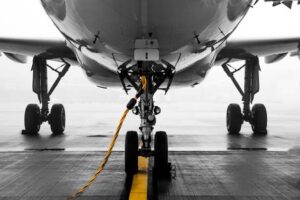 Image from Pexels
Image from Pexels
Airplane tires play a critical role in ensuring the safety and performance of an airplane during takeoff, landing, and taxiing operations. Despite their relatively small size compared to the aircraft itself, tires must withstand tremendous forces and operating conditions unique to aviation. This article will explore five essential aspects of airplane tires, shedding light on their construction, maintenance, and their crucial role in aviation safety and efficiency.
1. Construction and Composition
When it comes to taking off, landing, and taxiing, aircraft tires are designed to handle the high weights, speeds, and dynamic forces experienced during these activities. For the most part, airplane tires are made up of numerous layers of specific rubber compositions that are reinforced with nylon or steel wires. This is in contrast to the regular automotive tires. The tire can carry the weight of the airplane and resist the stress of high-speed revolutions because of these layers, which offer structural integrity and maintain longevity. Airplane tires also have a tread pattern that is intended to maximize traction on a variety of runway surfaces and weather conditions, which improves the performance of the tires in terms of grip and braking.
2. Size and Pressure Requirements
There are many different sizes and designs of airplane tires, each of which is designed to meet the unique needs of a particular kind of airplane and its operations. Several important aspects influence the load-carrying capability, performance, and overall safety of an airplane tire, including its size and the pressure at which it is inflated. Aviation rules and manufacturer requirements determine the actual tire size and inflation pressure for each airplane type. These specifications will take into consideration a variety of criteria, including the maximum takeoff weight, the design of the landing gear, and the surface conditions of the runway. To achieve optimum performance and reduce the likelihood of tire failure as a result of either overinflation or underinflation, it is very important to undertake regular tire pressure maintenance.
3. Durability and Service Life
Due to the demanding operating conditions they endure, airplane tires are subject to significant wear and tear over time. The service life of an airplane tire depends on various factors, including the number of landings, the severity of landing impacts, and exposure to environmental elements such as heat, moisture, and chemicals. To maximize durability and reliability, airplane tires undergo rigorous quality control testing and are designed to withstand thousands of landing cycles before requiring replacement. Regular inspections, tire rotation, and proper maintenance practices are essential to identify signs of wear and address potential issues before they compromise safety.
4. Retreading and Recapping
In commercial aviation, where cost-effectiveness is paramount, many airplane tires undergo retreading or recapping processes to extend their service life. Retreading involves removing the worn tread layer from the tire carcass and applying a new tread compound, effectively rejuvenating the tire and restoring its performance characteristics. Recapping, on the other hand, involves applying a new tread layer over the existing tread surface, providing additional mileage and traction. These processes offer significant cost savings compared to purchasing new tires and help reduce environmental impact by minimizing waste.
5. Impact of Tire Condition on Flight Safety
The condition of airplane tires directly affects flight safety, as they are the primary point of contact between the airplane and the ground. Damaged or improperly inflated tires can compromise braking performance, directional control, and the ability to absorb landing impacts, increasing the risk of runway excursions, tire blowouts, and other safety incidents. Therefore, regular tire inspections, pressure checks, and tread depth assessments are essential to identify potential issues and address them proactively. Additionally, pilots and maintenance personnel receive training on recognizing and mitigating tire-related hazards to ensure the safe operation of the airplane.
Conclusion
In conclusion, airplane tires are critical components of aviation safety and performance, designed to withstand the demanding conditions of flight operations. Their construction, size, inflation pressure, and maintenance requirements are carefully regulated to ensure optimal performance and safety. By understanding the key aspects of airplane tires, pilots, maintenance crews, and airline operators can implement effective maintenance practices and mitigate risks associated with tire-related incidents. Ultimately, prioritizing tire integrity and adhering to best practices contribute to safer and more efficient flight operations, benefiting passengers, crew, and aviation stakeholders alike.




















